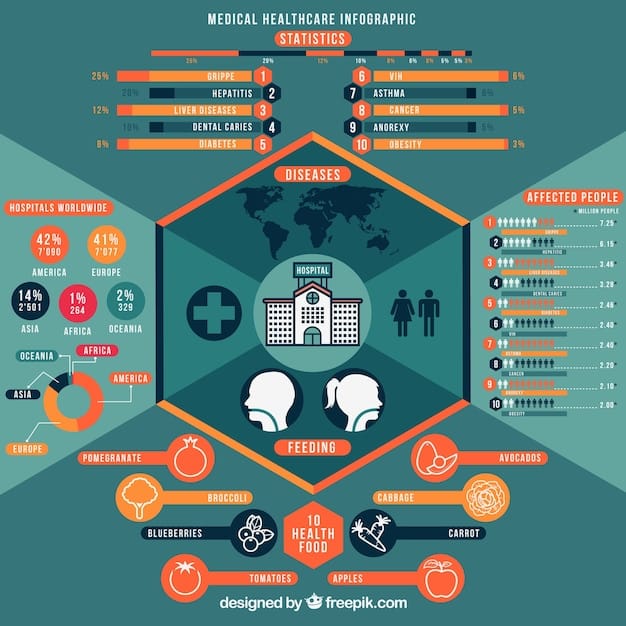Mastering US MedTech Reimbursement: A Startup Guide for 2025

Mastering US MedTech Reimbursement: A Practical Guide for Startups in 2025 offers a comprehensive overview of navigating the complex reimbursement landscape, focusing on strategies, key considerations, and practical steps for MedTech startups to secure sustainable financial viability in the US market.
Navigating the US healthcare system can be daunting, especially for MedTech startups. Mastering US MedTech Reimbursement: A Practical Guide for Startups in 2025 is crucial for ensuring your innovative technology reaches patients and achieves financial success. Let’s delve into the essential aspects of reimbursement strategies.
Understanding the US MedTech Reimbursement Landscape
The US healthcare reimbursement system is a complex web of payers, regulations, and coding systems. Understanding this landscape is the first step towards securing adequate reimbursement for your MedTech innovation. This section provides an overview of the key players and processes involved.
Key Players in US Healthcare Reimbursement
Navigating the US MedTech reimbursement landscape requires knowing the main players. These include government agencies, private insurers, and self-insured employers.
- Centers for Medicare & Medicaid Services (CMS): CMS oversees Medicare (for the elderly and disabled) and Medicaid (for low-income individuals), setting reimbursement policies that often influence private payers.
- Private Insurers: Companies like UnitedHealthcare, Anthem, and Aetna provide health insurance to a large segment of the US population. Their reimbursement decisions are crucial for MedTech adoption.
- Self-Insured Employers: Many large employers directly pay for their employees’ healthcare costs, giving them significant influence over coverage decisions.

The Reimbursement Process: A Simplified View
The reimbursement process generally involves several steps, from the initial medical service to the final payment. Understanding each step is crucial for optimizing your reimbursement strategy.
- Coding: Healthcare providers use standardized coding systems (like CPT and ICD-10) to describe medical procedures and diagnoses. Accurate coding is essential for proper reimbursement.
- Submission: Providers submit claims to payers, including the relevant codes and documentation.
- Review: Payers review claims to determine medical necessity and coverage eligibility.
- Adjudication: Payers either approve or deny the claim based on their policies.
- Payment: If approved, the payer reimburses the provider according to the agreed-upon rates.
Understanding these key players and the reimbursement process is essential for MedTech startups aiming to succeed in the US market. By grasping the dynamics of the system, you can better navigate the complexities and secure appropriate reimbursement for your innovations.
Developing a Robust Reimbursement Strategy
A well-defined reimbursement strategy is vital for MedTech startups. It involves analyzing the market, identifying relevant codes, and developing a compelling value proposition.
Market Analysis and Payer Research
Understanding your target market and the payers within that market is crucial for developing an effective reimbursement strategy. Conduct thorough research to identify payer coverage policies, reimbursement rates, and potential barriers to adoption.
- Identify Target Payers: Determine which payers are most likely to cover your technology based on patient demographics and geographic location.
- Analyze Coverage Policies: Review payer policies to understand coverage criteria, coding requirements, and any specific documentation needed.
- Assess Reimbursement Rates: Research the reimbursement rates for comparable technologies to estimate potential revenue.
Coding and Coverage: Key Considerations
Selecting the right codes and securing coverage are critical steps in the reimbursement process. Engage with coding experts and payer representatives to navigate these complexities.
- CPT, ICD-10, and HCPCS Codes: Understand the differences between these coding systems and select the appropriate codes for your technology.
- New Technology Add-on Payment (NTAP): Explore opportunities to obtain NTAP status for innovative technologies that provide a substantial clinical improvement.
- Coverage with Evidence Development (CED): Consider CED as a pathway to coverage by conducting clinical studies to demonstrate the value of your technology.
Developing a solid reimbursement strategy that includes thorough market analysis, payer research, and careful attention to coding and coverage is essential for MedTech startups aiming to achieve sustainable financial success in the US.
Navigating Coding, Coverage, and Payment
Coding, coverage, and payment are three interconnected pillars supporting successful MedTech reimbursement. They require diligent planning, execution, and adaptation to achieve sustainable financial outcomes.
Mastering Medical Coding for MedTech
Accurate and strategic medical coding is foundational to successful reimbursement. This involves selecting and applying the correct codes from various coding systems to reflect the procedures and diagnoses accurately.
Navigating the complexities of CPT, ICD-10, and HCPCS codes requires specialized knowledge. Startups should invest in expertise to ensure claims are coded correctly, reducing the risk of denials and delays.
Securing Coverage for Your Innovation
Obtaining favorable coverage decisions from payers involves demonstrating the clinical and economic value of your MedTech innovation. A well-prepared coverage dossier is essential to support your case.
- Clinical Evidence: Present robust clinical data from well-designed studies to demonstrate the safety and efficacy of your technology.
- Economic Value: Highlight the economic benefits of your technology, such as reduced hospital stays, fewer complications, and improved patient outcomes.
- Payer Engagement: Proactively engage with payers to understand their coverage criteria and address any concerns they may have.

Optimizing Payment Strategies
Negotiating favorable payment rates and optimizing billing practices can significantly impact your revenue. Understand the different payment models and leverage data to support your payment requests.
Consider value-based payment models that align payment with patient outcomes. These models can incentivize the adoption of innovative technologies that improve quality and reduce costs.
By mastering medical coding, securing coverage through comprehensive documentation, and optimizing payment strategies, MedTech startups can improve their reimbursement success.
Building Relationships with Payers and Providers
Establishing strong relationships with payers and healthcare providers is essential for MedTech startups. These relationships can facilitate coverage decisions, drive adoption, and improve reimbursement outcomes.
Engaging with Payer Organizations
Proactive engagement with payer organizations can help you understand their coverage priorities and demonstrate the value of your technology. Attend industry conferences, participate in payer advisory boards, and schedule meetings with payer representatives.
- Understand Payer Priorities: Identify the clinical areas and patient populations that are of greatest interest to payers.
- Present Your Value Proposition: Clearly communicate the clinical and economic benefits of your technology.
- Address Payer Concerns: Be prepared to answer questions and address any concerns that payers may have about your technology.
Collaborating with Healthcare Providers
Partnering with healthcare providers can help you generate clinical data, drive adoption, and improve reimbursement outcomes. Build relationships with key opinion leaders and clinicians who are passionate about your technology.
- Conduct Clinical Studies: Partner with providers to conduct clinical studies that demonstrate the value of your technology in real-world settings.
- Provide Training and Support: Offer training and support to providers to ensure they are comfortable using your technology.
- Gather Feedback: Solicit feedback from providers to identify areas for improvement and refine your technology.
Building strong relationships with both payers and providers can give MedTech startups a competitive edge, improving chances of coverage and adoption.
Leveraging Real-World Evidence and Data Analytics
Real-world evidence (RWE) and data analytics are increasingly important in healthcare reimbursement. Leveraging these tools can help you demonstrate the value of your technology and support your reimbursement claims.
Collecting Real-World Evidence
RWE is data collected outside of traditional clinical trials, such as electronic health records, claims data, and patient registries. This type of data can provide valuable insights into the performance of your technology in real-world settings.
- Identify Relevant Data Sources: Determine which data sources are most relevant to your technology.
- Collect and Analyze Data: Collect and analyze data to generate insights into the clinical and economic outcomes of your technology.
- Publish Your Findings: Publish your findings in peer-reviewed journals to disseminate your results and build credibility.
Utilizing Data Analytics
Data analytics can help you identify trends, patterns, and insights in your data. Use data analytics to demonstrate the value of your technology to payers and providers.
- Identify Key Performance Indicators (KPIs): Determine which KPIs are most important to payers and providers.
- Track and Monitor KPIs: Track and monitor KPIs to demonstrate the performance of your technology.
- Communicate Your Results: Communicate your results to payers and providers to demonstrate the value of your technology.
Leveraging real-world evidence and data analytics not only boosts your chances of reimbursement but also builds trust and credibility with payers and providers.
Preparing for 2025: Trends and Predictions
As we approach 2025, several trends are shaping the MedTech reimbursement landscape. Staying ahead of these trends is crucial for startups looking to succeed in the US market.
Increased Focus on Value-Based Care
Value-based care models, which focus on paying for outcomes rather than services, are becoming increasingly prevalent. MedTech startups need to demonstrate the value of their technologies in terms of improved patient outcomes and reduced costs.
Embrace value-based payment models and align incentives with payers and providers to deliver value to patients and the healthcare system. This includes focusing on preventive care and chronic disease management.
Greater Emphasis on Digital Health and Telemedicine
Digital health technologies and telemedicine are transforming healthcare delivery. MedTech startups should explore opportunities to integrate their technologies with digital health platforms and telemedicine services.
Telehealth is expanding access to care, particularly in rural areas, and driving demand for remote monitoring devices.
Evolving Regulatory Landscape
The regulatory landscape for MedTech devices is constantly evolving. Stay informed about changes in FDA regulations, coding guidelines, and reimbursement policies. Regularly review CMS announcements and payer updates.
By anticipating these trends and adapting your strategies, you can position your MedTech startup for success in the dynamic US reimbursement environment. Continuous learning and adaptation are imperative.
| Key Point | Brief Description |
|---|---|
| 💡 Reimbursement Strategy | Develop a robust reimbursement strategy early on, considering market dynamics and payer policies. |
| 🤝 Payer Relationships | Build strong relationships with payers to facilitate coverage decisions and adoption. |
| 📊 Real-World Evidence | Leverage real-world evidence to demonstrate the value of your technology. |
| 🔮 2025 Trends | Prepare for trends like value-based care, digital health, and evolving regulations. |
Frequently Asked Questions (FAQ)
The initial step is to thoroughly understand the US healthcare reimbursement landscape, including key players such as CMS and private insurers, as well as the overall reimbursement process.
Accurate coding using systems like CPT and ICD-10 is essential for proper reimbursement because it ensures claims are correctly processed and reflect the medical services provided.
Startups can build relationships with payers by attending industry conferences, participating in advisory boards, and scheduling direct meetings to present their value proposition.
Real-world evidence is data collected outside clinical trials, offering insights into technology performance in real settings, and supporting reimbursement claims by demonstrating tangible outcomes.
By 2025, MedTech startups must prepare for a greater focus on value-based care, growing digital health integration, and an evolving regulatory environment, requiring continuous adaptation.
Conclusion
Mastering US MedTech reimbursement requires a multifaceted approach that combines a deep understanding of the healthcare landscape, strategic planning, strong relationships, and a commitment to demonstrating value. By focusing on these key areas, MedTech startups can increase their chances of success in the competitive US market.





